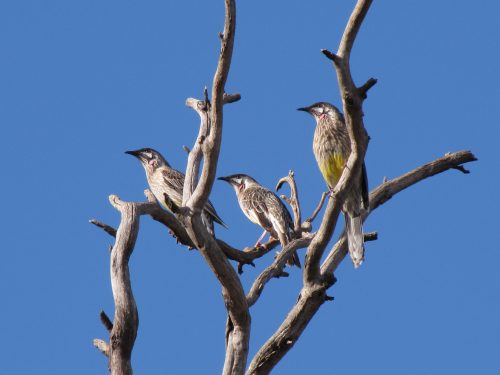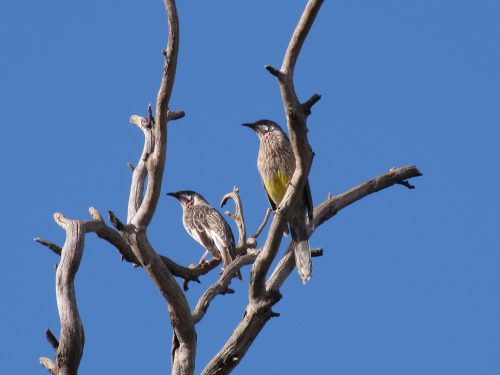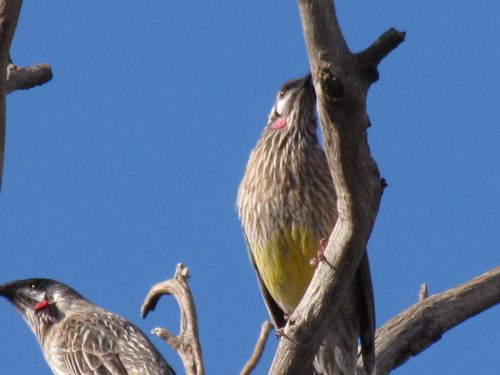I was swooped by a wattlebird
On our trip to Sydney last week, we stopped for a brief rest at the Wagga Wagga Botanic Gardens. This is one of our favourite stopping places on our way from home in Murray Bridge, South Australia, when we are going to Sydney to visit family. On this occasion, we stopped there to have morning tea, and to change drivers.
The botanic gardens in Wagga Wagga have a good representative range of both Australian and exotic plants. The gardens are beautifully set out with plenty of areas of lawn for visitors to have picnics. The good range of plants means that visitors can see something flowering at most times of the year. This also means that there is also a good range of birds present in the gardens and the surrounding environment no matter when one visits.
On this occasion, we were somewhat pressed for time, so I only had the chance to make a small list of the birds I saw. I didn’t even get my camera out, so the photos in today’s post were taken a few weeks ago near our home. I was in the middle of having a cup of tea and looking around at the flowering Grevilleas and Callistomens in the Australian Native Garden section.
I saw a Red Wattlebird land in the bush next to me. I thought it was about to feed on the many flowers in this bush. Instead, as it perched there, it screeched at me – as if it was growling at me. It flew off briefly, returning very low over my head and clacking its beak as it again flew into the bush. It repeated this action several times, each time swooping low over my head. It seemed to be irritated by my presence.
Its next action revealed its true intention. A small crumb from my piece of cake fell to the ground. Immediately, the Wattlebird swooped down and picked it up. It was obviously calling to me to feed it some cake. I guess many visitors do feed the birds during their picnics. In Australia, this is discouraged because many forms of human food are actually harmful to our birds. There is no reason to feed our birds because they have access to a wide range of natural foods.
The most interesting thing about this close encounter was that this individual had learned to swoop humans in order to get food handed to it. I have been swooped by Wattlebirds before, but it is a fairly rare occurrence in my experience.
Good birding,
Trevor
Further reading:
- The problem of swooping magpies
- Do Blackbirds swoop? Dealing with aggressive birds.
- Pesky Plovers – dealing with swooping birds
Red wattle bird in Eremophila bush
Over the last few months the Eremophila maculata (compact form) bush in our driveway has been covered in bright flowers. It is a stunning picture and we enjoy seeing it in flower for so long. The Red wattlebirds also appreciate the flowers and visit the bush many times each day for a feed.
Other species that enjoy a feed here include the New Holland Honeyeaters, Spiny-cheeked Honeyeaters and the Singing Honeyeaters. Not to be outdone, the resident Mallee Ringneck Parrots also feed on the flowers. The ringnecks are far less delicate feeders, though, because they enjoy eating the whole flower, not just feasting on the nectar.
Aggressive Red Wattlebirds
This morning I was suddenly aware of a noisy disturbance just outside my office window. I looked up to see three Red Wattlebirds locked in a furious battle in the garden bed. In fact, I thought at first it was only two fighting each other. As I reached for my camera, they flew off, and I saw that there had been three birds fighting.
What caused this kerfuffle? I have no idea. As they flew off two of them were aggressively chasing the third one. The battle may well have continued elsewhere.
Red Wattlebirds nesting
I was quietly having my breakfast this morning when a Red Wattlebird flew into the bush near our sun room. It proceeded to pull off a small twig from a Melaleuca bush. It then flew off rapidly to a Eucalyptus tree next to the driveway. Less than a minute later it was back again, swinging on a small twig until it was dislodged, then off to the tree again. It repeated the action every minute or so.
After finishing my breakfast – and ignoring the newspaper – I wandered out to the driveway to have a look. Sure enough, a half constructed nest was located high in the thick foliage. I actually had to follow the bird’s flight to locate the nest. It’s well hidden from prying eyes. While I watched the another Red Wattlebird flew in from a different part of the garden and added to the nest.
I’ll have to keep an eye on this nest over the coming few weeks to watch for evidence of chicks.
It is spring here in South Australia and many birds are busy nesting of feeding young.
Further reading:
Synchronised flying by wattlebirds
I regularly get comments and questions from readers of this blog. It is one of the delights of having a blog. Today I received a question via my email contact form. I must admit I’ve never witnessed this strangely compelling activity on the part of Red Wattlebirds. Can any readers help?
I stumbled on your page while doing a search on what we call Synchronised Red Wattle Birds. For the past few years we have noticed an interesting behaviour of 2 red wattle birds in our back yard (Coromandel Valley, South Australia). They fly in unison from the back fence and land at the same time on the railing of our balcony. Then they squawk at each other turn around and fly off at exactly the same time and land again on the back fence at exactly the same time. They can repeat this for up to 1/2 an hour at a time.
If one accidentally takes off before the other, it quickly returns, squawks and then they leave together. Have you seen this behaviour before and do you have any idea what it is all about? We thought maybe flight training for young but perhaps they are practicing for a synchronised flying competition.
It is great fun to watch and they look like they are having a super time.
Cheers Leslie
This sounds like they are having great fun. Could it be just play? Is it sexual behaviour? I’ve done a search of my reference books and there is no mention of this behaviour. Over to my readers – use the contact form or the comments section below.









